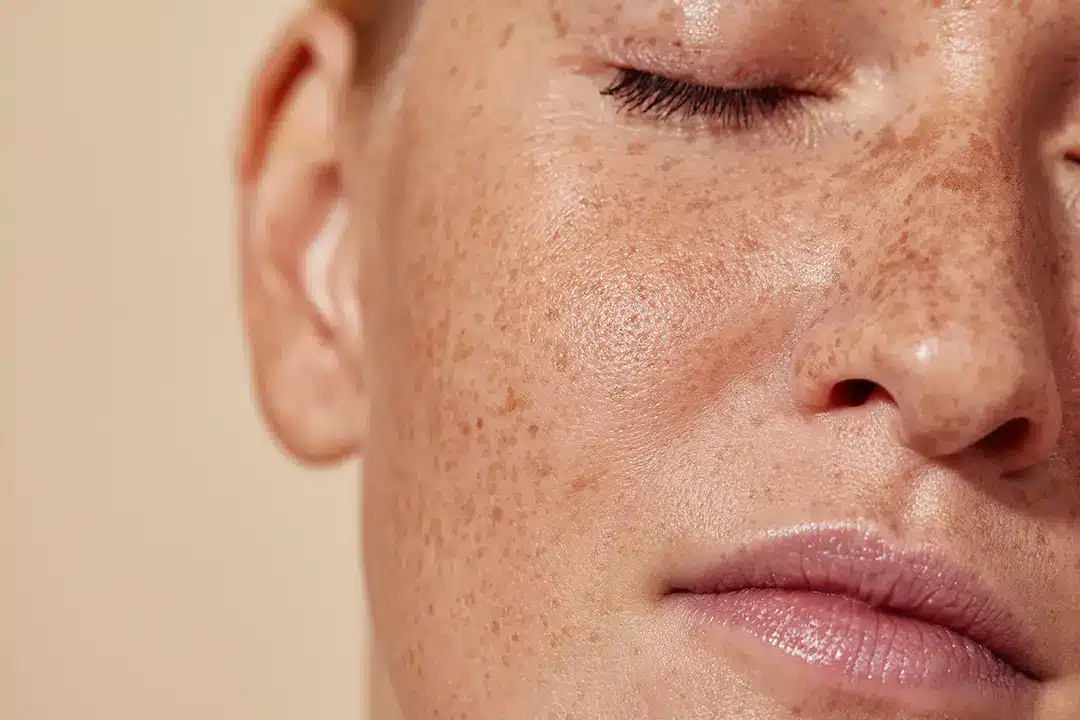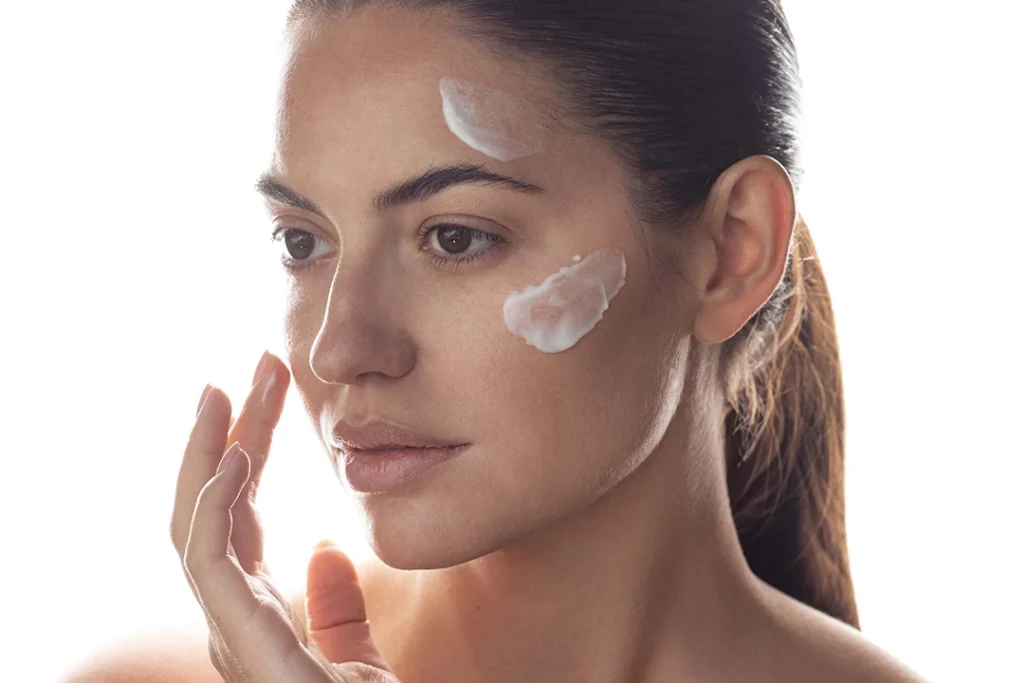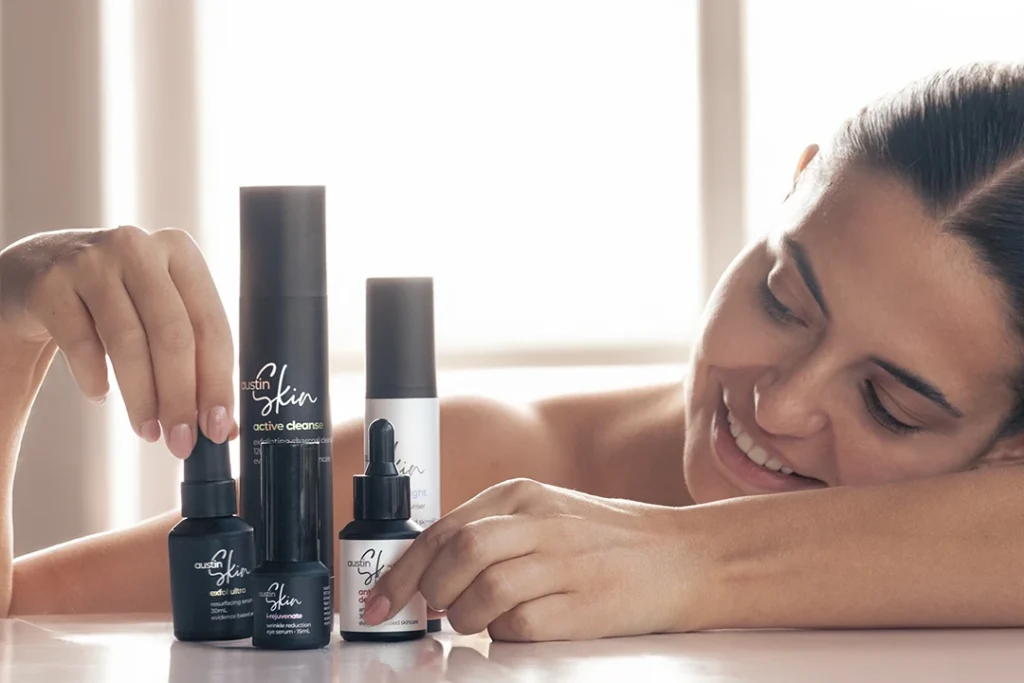Dark Skin Patches: 3 Reasons Your Skin is Turning on You
Three factors, individually or together, will most likely lead to unwanted colour and texture variations appearing:
- Hyperpigmentation
- Skin cancer
- Freckles
“Understanding the key differences behind the causes of discoloured skin is crucial for proper diagnosis and management,” says Dr Austin.
Everything You Need to Know about Hyperpigmentation
Melanin is the pigment that gives skin its colour. If you have too much melanin, you may develop dark patches and/or blemishes known as hyperpigmentation. Excess melanin can:
- Cause patches in a variety of sizes and shapes, with irregular borders
- Appear in a range of colours from light to dark brown, as well as grey and purple
Why do you have too much melanin in your skin? That’s an excellent question. Melanin production can go sideways when trigged by a variety of factors, some related to ageing. It commonly occurs on sun-exposed areas like the face, neck, hands, and arms where UV rays stimulate melanin production, leading to sunspots, age spots, and melasma (dark patches on the face).
Other triggers for hyperpigmentation include:
- Inflammation: Acne, eczema, and insect bites can trigger post-inflammatory hyperpigmentation, especially in darker skin tones.
- Hormonal changes: Pregnancy, hormonal medications, and thyroid disorders can disrupt melanin production, causing conditions like melasma.
- Certain medications: Minocycline, hydrocortisone, and some birth control pills can cause hyperpigmentation as a side effect.
In-Clinic Treatments for Hyperpigmentation
“Hyperpigmentation, in and of itself, is not a medically concerning problem,” explains Dr Austin, who adds, “but it can be aesthetically displeasing.” For patients who are seeking a more uniform tone and texture to their skin, Austin Clinic offers:
Exfoliation with Facial Acids – Medical-grade skin acids work by exfoliating the top layer of your skin. They help even out your skin tone and make it smoother overall. Popular options include alpha hydroxy acids, such as glycolic, lactic, citric, malic, or tartaric acid, azelaic acid, kojic acid, salicylic acid, and vitamin C. Face acids work well for mild hyperpigmentation on fairer skin tones.
Retinoids: Retinoids are derived from vitamin A and can penetrate deep into the skin to treat the layers beneath your epidermis. “Retinoids can come in either a prescription or OTC formula,” notes Dr Austin who cautions, “OTC versions tend to be weaker.” The prescription retinoid tretinoin (Retin-A) is likely to be more effective. Additionally, while over-the-counter retinoids may be suitable for most skin tones, you should double-check with your skin professional if you have darker skin and plan on using the products long term.
Chemical peels: These treatments use acids at stronger concentrations to treat the desired area of skin. Chemical peels are used when topical therapy fails.
Laser therapy: This treatment uses a laser to remove the top layer of skin, which can help reduce the appearance of hyperpigmentation.
Intense pulsed light (IPL) therapy: This treatment uses a broad-spectrum light source to target the melanin in the skin, which can help reduce the appearance of hyperpigmentation.
Skin Cancer? Act Now
Australia has the dubious distinction of being known as the skin cancer capital of the world with a disproportionate number of cases of:
Melanoma: The most aggressive type, often appearing as an asymmetrical mole with irregular borders, varied colours, and a growing diameter.
Basal cell carcinoma: Slow-growing, pearly or translucent bump with raised edges.
Squamous cell carcinoma: Red, scaly patch or bump that may bleed or crust.
“Nearly half a million Australians are treated annually for one or more non-melanoma skin cancers and more than 11,000 individuals will be diagnosed with melanoma,” says Dr Austin. “It doesn’t have to be this way. A simple skin check can lead to early detection and treatment.”
Skin Cancer Checks: At-Home and at Austin Clinic
“Annual cancer checks are essential for the early detection and treatment required to prevent its spread and ensure positive outcomes,” comments Dr Austin,” but patients can take a great deal of their care into their own hands by performing routine skin cancer checks.”
The Cancer Council of Australia has an online guide for self-check for skin cancer. Here’s what to look for:
- Lesions can be single or multiple, varying in size and shape.
- Colours can range from brown, black, and pink, to red, white, and yellow.
- Many have irregular borders, uneven surfaces, and bleeding or crusting.
- They can appear anywhere on the body, including sun-exposed and non-exposed areas.
“Not all skin cancer interventions require surgery, so please don’t let the fear of treatment keep you from getting a proper diagnosis,” says Dr Austin. “A simple biopsy can determine the stage of cancer progression and whether surgery, radiation, or chemotherapy is necessary.”
Don’t Be Frightened of Freckles
Do you have a dusting of small brown spots splashed across your nose, cheeks, and chin? If so, you’re not alone. Millions of people worldwide have freckles. The reason: genetics. Freckles are the result of a benign mutation gene (MC1R) that regulates your skin and hair colour. It takes two parents with this gene to produce freckles in an offspring.
How can you identify freckles? It’s easy:
- Ephelides freckles are flat, light-brown spots on the skin, and are the most common.
- Lentigines are usually darker and become more noticeable with age (liver spots).
General attributes of all freckles include:
- Tiny flat spots, usually round or oval in shape.
- Appear in clusters or groups, especially with sun exposure.
- Commonly affect people with fair skin and light hair or eyes.
Some people love their freckles, others, not so much. For those in the latter camp, Austin Clinic offers light-based treatments including IPL and BBL.
With the help of Austin Clinic’s expert skin team, you can understand the differences among skin discolourations and make informed decisions about your skin health. Need more support? Our team is here for you.




